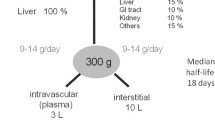Abstract
Albumin is a much abused and expensive drug in intensive care units. One of the motivations for its use is the prevention of pulmonary edema by enhancing the colloid osmotic pressure (COP). Fear of pulmonary edema has led to the formulation of a magic (arbitrary) albumin value varying from one intensive care unit to another. Many intensive care units start substituting albumin when it is below 25 g/l. The objective of this paper is to look at the rationale of this policy. Our results show that in intensive care patients, with a variety of primary diagnoses, a poor correlation exists between COP and serum albumin concentration (r=0.56; p(0.001). To get an index of the colloid osmotic status of the I. C.-patient measuring albumin concentration is useless and COP should be measured instead. From 19 patients with a COP in the 15.0–20.0 mmHg range (corresponding albumin range: 12.0–25.0 g/l) and from 10 patients with a COP in the 11.6–15.0 mmHg range (corresponding albumin range 10.5–19.2 g/l) none developed pulmonary edema. It is questionable if expensive, scarce albumin is the drug of choice with which to increase COP, for the mean increase (±SD) in COP after infusion of 100 grams albumin is 2.2 (±1.5) mmHg (p(0.001). Adopting a COP action level of 15 mmHg can lead to considerable savings.
Similar content being viewed by others
References
Landis EM, Pappenheimer JR (1963) Exchanges of substances through the capillary walls. In: Dow P (ed) Handbook of physiological knowledge and concepts, Sect 2. Circulation, Vol 2. Williams and Wilkins, Baltimore, pp 961
Landis EM (1943) Capillary pressure and capillary permeability. Physiol Rev 14:404
Lundsgaard-Hansen P, Pappova E (1974) Respiratorische Insuffizienz, kolloid osmotischer Druck und Albumintherapie. Infusionstherapie 1:624
Weil MH, Henning RJ, Puri VK (1979) Colloid oncotic pressure. Crit Care Med 7:113
Barclay SA, Bennett D (1987) The direct measurement of plasma colloid osmotic pressure is superior to colloid osmotic pressure derived from albumin or total protein. Intensive Care Med 13:114
Sprung CL, Isikoff SK, Hauser M, Eisler BR (1980) Comparison of measured and calculated colloid osmotic pressure of serum and pulmonary edema fluid in patients with pulmonary edema. Crit Care Med 8:613
Schmidt RF, Thews G (1983) Human physiology, Springer Berlin Heidelberg New York, pp 419
Guyton AC (1981) Textbook of medical physiology, 6 edn. Saunders, Philadelphia, pp 376
Haupt MT, Rackow EC (1982) Colloid osmotic pressure and fluid resuscitation with hetastarch, albumin and saline solutions. Crit Care Med 10:159
Puri VK, Howard M, Paidipaty BB, Singh S (1983) Resuscitation in hypovolemia and shock: a prospective study of hydroxyethyl starch and albumin. Crit Care Med 11:518
Moggio RA, Rha CC, Somberg FD, Praeger PI, Pooley RW, Reed GE (1983) Hemodynamic comparison of albumin and hydroxyethyl starch in postoperative cardiac surgery patients. Crit Care Med 11:943
Author information
Authors and Affiliations
Rights and permissions
About this article
Cite this article
Grootendorst, A.F., van Wilgenburg, M.G.M., de Laat, P.H.J.M. et al. Albumin abuse in intensive care medicine. Intensive Care Med 14, 554–557 (1988). https://doi.org/10.1007/BF00263529
Received:
Accepted:
Published:
Issue Date:
DOI: https://doi.org/10.1007/BF00263529




